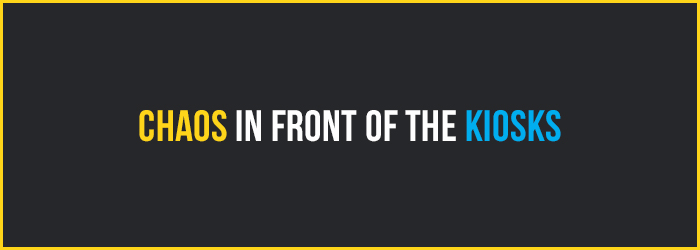
How to Eliminate the Chaos in Front of the Kiosks
The age of self-service is officially upon us as businesses across industries turn to kiosks to facilitate customer order-taking, ticketing, check-ins, check-outs, and an increasing array of other transactions.
Organizations are being drawn to self-service for a few key reasons:
- To cut down on labor costs or to reallocate labor to other tasks while customers primarily serve themselves
- To remove waiting lines and decrease wait times as customers serve themselves more efficiently
- To give customers more control over their service experience
These reasons sound compelling until reality hits and chaos ensues as an influx of customers causes a backup of people waiting for their turn, jockeying for position, and generally trying to figure out where a line should form.
The surprising reality is that self-serve kiosks don’t really remove the waiting line and when the resulting chaos ensues, all the other benefits of the self-service approach are quickly diminished. The point is, installing a bank of self-service kiosks doesn’t eliminate the line; it simply changes where the line forms.
The rules of queue management still apply.
Planning queue management for a line of kiosks or even a single kiosk, is the same as planning queues for a line of cashiers or service agents. Remember that customers still want to feel a sense of order and fairness in the process, they want to know where the line begins and ends, they want a clear path through the queue, and they want to know where the next available kiosk is and whose turn it is to approach the kiosk. These objectives can be met when you apply tried and true queue management strategies to your self-service area.
Consider this simple 2-step approach:
- Employ stanchions and retractable belts to form a single line queue that can easily expand or retract based on crowd volume. The single line queue instills an immediate sense of order and fairness, and is also proven to be the most efficient queue formation.
- Use a queue analytics system with call-forwarding to monitor kiosks and the queue and automatically determine when a kiosk opens up and when people are waiting. As a kiosk becomes available, the call-forward system can auto-alert the next waiting customer and guide them to the open kiosk via a station light and/or video announcement.
With a solid queue management approach, you can maximize the benefits of a self-service approach and minimize the chaos in front of the kiosks.
SUSCRIBIRSE
Suscríbase para mantenerse al día con los nuevos productos, información y noticias sobre los recursos.
ENTRADAS DE BLOG RECIENTES
Theft at the Register: How Strategic Queue Design Protects Profits
Leer el artículo completoRapid Deployment Crowd Control: JetTrac Portable Barriers For The Biggest Spaces
Leer el artículo completo4 Psychological Reasons Your Customers Hate Waiting In Line
Leer el artículo completoFrom Bleachers To Bookstores: 4 Campus Crowd Control Solutions
Leer el artículo completo








